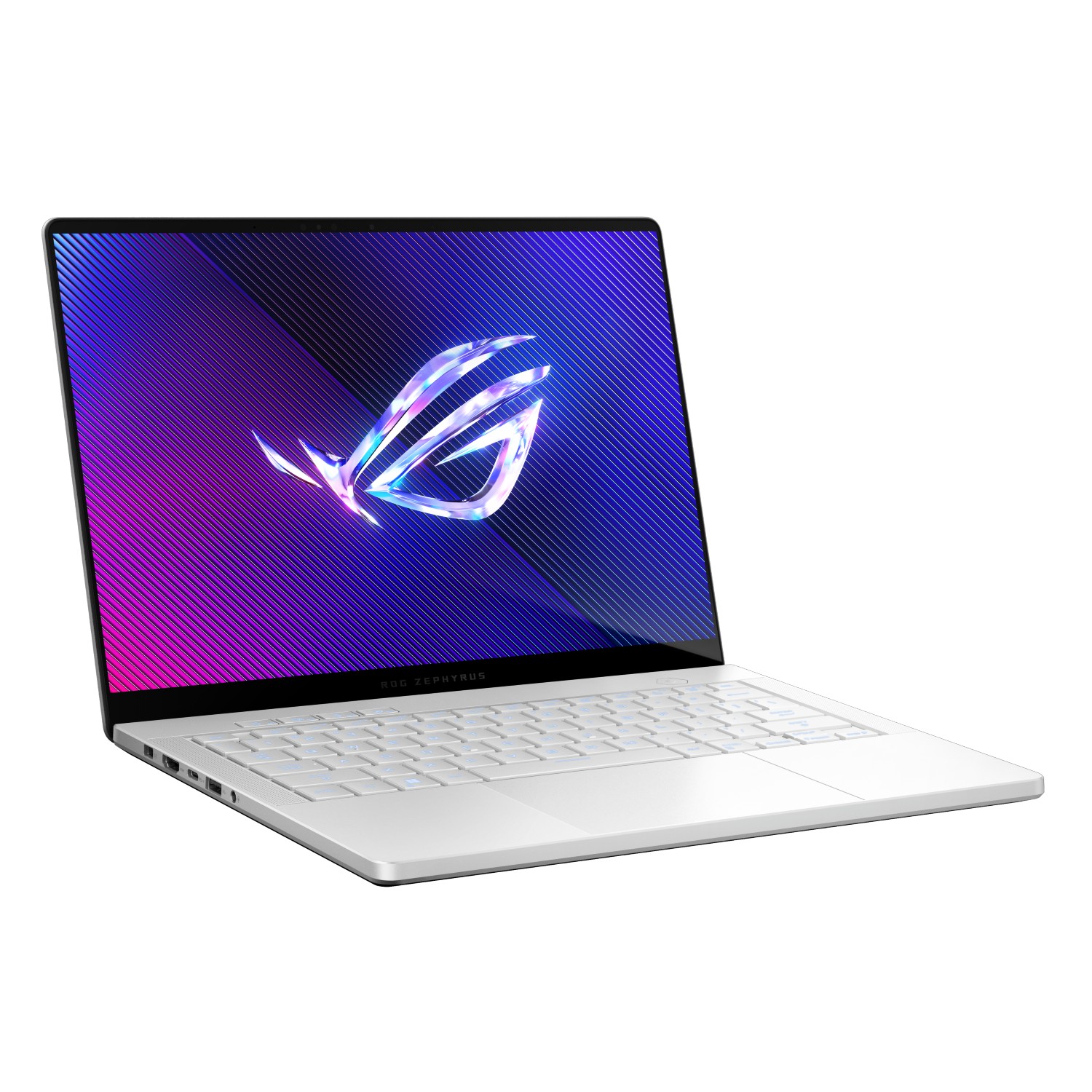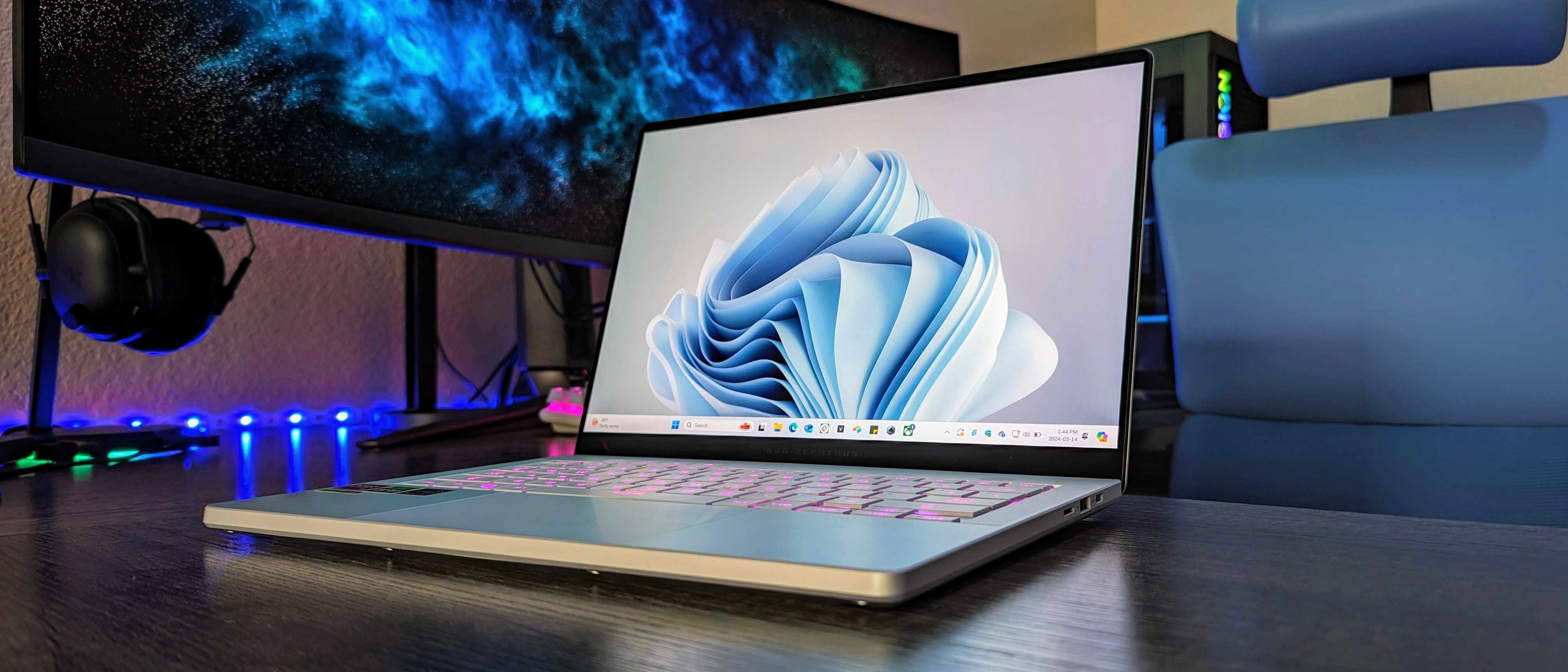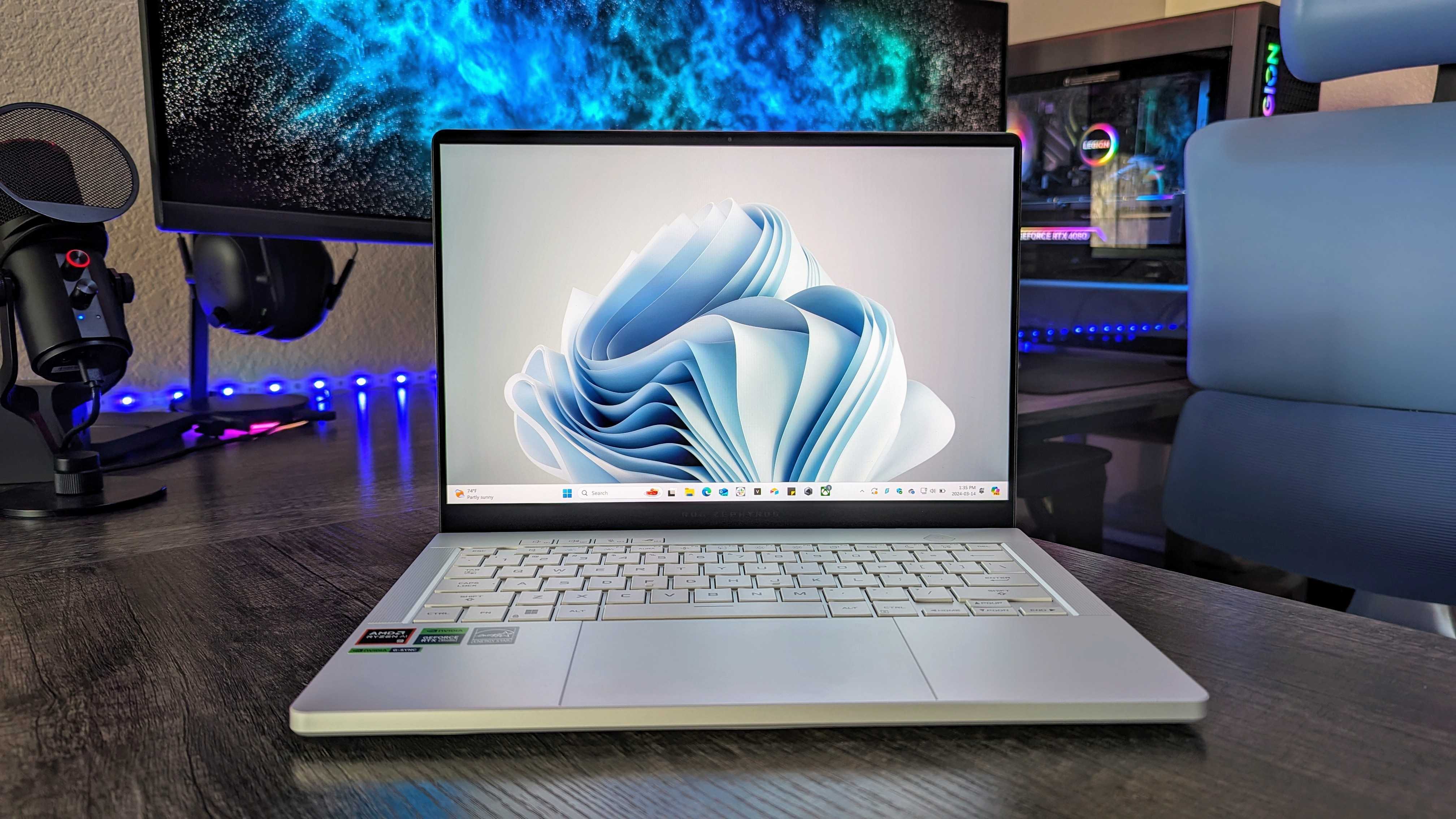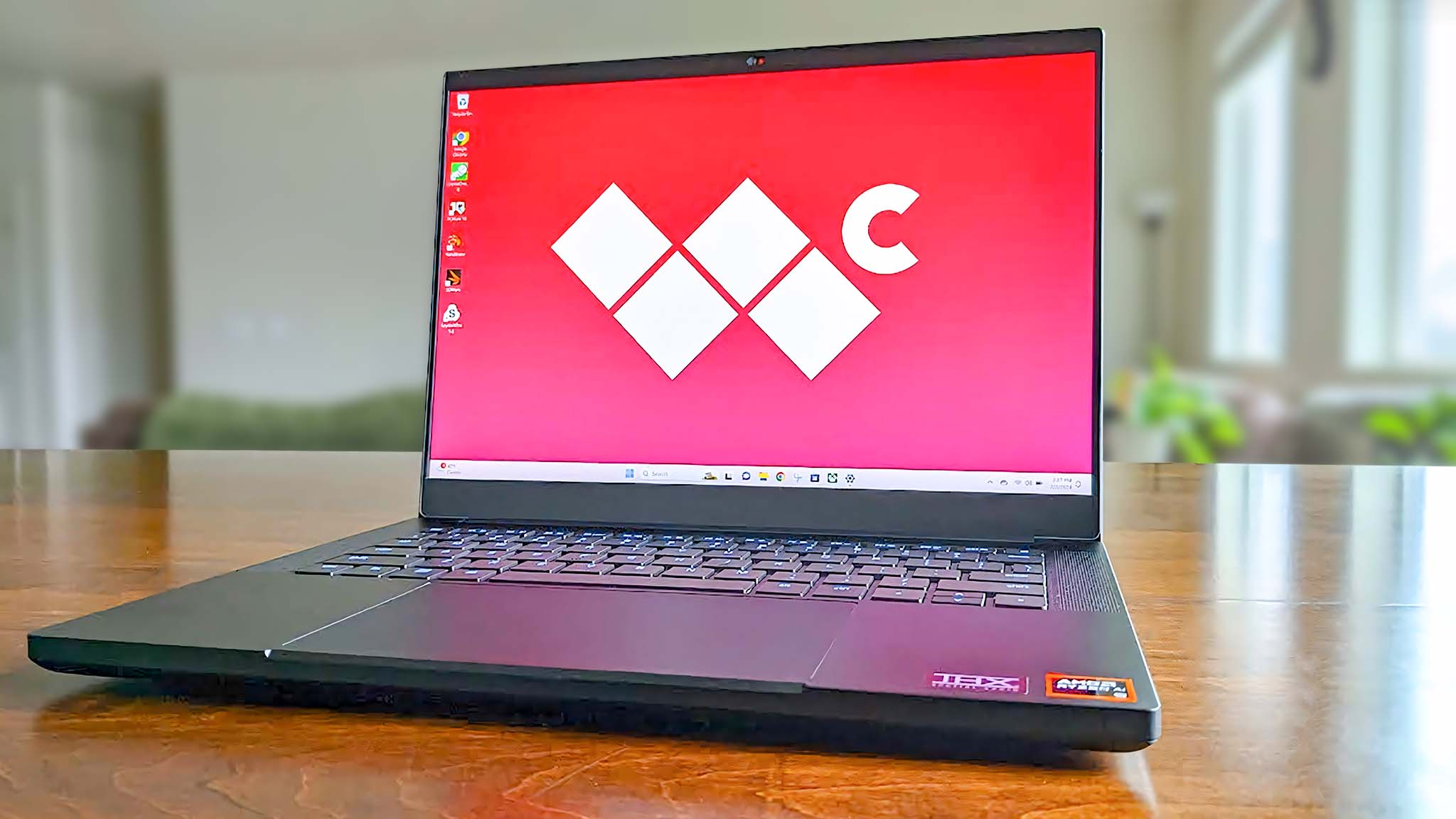
The ASUS ROG Zephyrus G14 for 2024 costs hundreds less than the Razer Blade 14, and it offers similar performance hardware as well as a high-res OLED display. If you're looking to maximize price to performance (and features), it should be the way to go.
Pros
- Glorious 3K OLED display at 120Hz
- Strong AMD Ryzen and NVIDIA RTX performance
- More affordable compared to the Blade 14
- Thinner and lighter than the Blade 14
- Six speakers with great sound
Cons
- Display refresh rate isn't as high
- No webcam privacy shutter
- RAM is soldered

Razer's Blade 14 received mostly a performance refresh for 2024, and it remains a high-end gaming laptop perfect for anyone who's often on the move. However, the Zephyrus G14's redesign is quite impressive, and the fact that you can get it for hundreds less will send a lot of people to the ASUS laptop.
Pros
- 1080p + IR webcam includes a privacy shutter
- QHD+ IPS display hits a 240Hz refresh rate
- Clean and sleek design with a great keyboard and touchpad
- RAM and SSD can be upgraded
Cons
- Not as thin and light as the G14
- Audio isn't as impressive
- No OLED display option
- Far more expensive
ASUS and Razer make some of the best laptops on the market today, especially if you're shopping for something that can handle a premium gaming experience.
The ROG Zephyrus G14 and the Blade 14 were both refreshed for 2024, and we tested and reviewed both devices here at Windows Central. While they both received Best Awards in their respective reviews, there are some big differences to be aware of when shopping.
In general, the Zephyrus G14's high-res OLED display, thin and light build, 10W speaker setup, and strong performance are going to be more attractive if only because you can pick up a model for hundreds less than a Blade 14. On the other hand, Razer's 240Hz IPS display, upgradeable RAM, and sleek design will be attractive to some even at a much higher price.
Let's take a close look at the similarities and differences between the ROG Zephyrus G14 and Blade 14 for 2024 to help you pick the right device for your next gaming laptop.
ASUS ROG Zephyrus G14 (2024) vs. Razer Blade 14 (2024): Specs
It's worth taking a look at the specifications that make up each laptop before delving further into deeper comparisons of design, features, display, performance, battery life, and more.
| Header Cell - Column 0 | ASUS ROG Zephyrus G14 (2024) | Razer Blade 14 (2024) |
|---|---|---|
| CPU | AMD Ryzen 9 8945HS | AMD Ryzen 9 8945HS |
| RAM | 16GB, 32GB LPDDR5x-6400MHz (soldered) | 16GB, 32GB DDR5-5600MHz (upgradeable) |
| GPU | NVIDIA RTX 4050 Laptop, RTX 4060 Laptop, RTX 4070 Laptop | NVIDIA RTX 4060 Laptop, RTX 4070 Laptop |
| Storage | 1TB M.2 PCIe 4.0 NVMe SSD | 1TB M.2 PCIe 4.0 NVMe SSD |
| Camera | 1080p + IR | 1080p + IR, webcam shutter |
| Speakers | Four 2W woofers, two 1W tweeters, Dolby Atmos | Dual speakers |
| Display | 14 inches, 2880x1800, OLED, 120Hz refresh rate, 0.2ms response time, G-Sync, MUX switch, NVIDIA Advanced Optimus, Dolby Vision | 14 inches, 2560x1600, IPS, 240Hz refresh rate, AMD FreeSync Premium |
| Ports | USB4, USB-C 3.2 (Gen 2), two USB-A 3.2 (Gen 2), HDMI 2.1, 3.5mm audio, UHS-II microSD card reader | Two USB4, two USB-A 3.2 (Gen 2), HDMI 2.1, 3.5mm audio |
| Wireless | Wi-Fi 6E, Bluetooth 5.3 | Wi-Fi 7, Bluetooth 5.3 |
| Battery | 73Wh | 68.1Wh |
| Dimensions | 12.24 x 8.66 x 0.63-0.64 inches (311mm x 220mm x 15.9-16.3mm) | 12.23 x 8.97 x 0.7 inches (310.7mm x 228mm x 17.99mm) |
| Weight | 3.31 pounds (1.5kg) | 4.05 pounds (1.84kg) |
| Price | From $1,600 | From $2,200 |
ASUS ROG Zephyrus G14 (2024) vs. Razer Blade 14 (2024): Price and availability
The ASUS ROG Zephyrus G14 (2024) is available primarily at Best Buy and Amazon, and prices generally start at about $1,600. The entry-level model has an AMD Ryzen 9 8945HS processor (CPU), 16GB of LPDDR5x RAM, NVIDIA RTX 4060 Laptop graphics card (GPU), and a 1TB M.2 PCIe 4.0 NVMe solid-state drive (SSD).
Jumping up to about $2,000 lands you 32GB of RAM and an NVIDIA RTX 4070 Laptop GPU, with otherwise similar specs. ASUS offers one 14-inch OLED display option across models, with a 2880x1800 resolution and 120Hz refresh rate.
Razer's latest Blade 14 model for 2024 starts at about $2,200. These models include an AMD Ryzen 9 8945HS CPU, 16GB of DDR5-5600MHz RAM, 1TB M.2 PCIe 4.0 NVMe SSD, and a NVIDIA RTX 4060 Laptop GPU.
Bumping the specs up to 32GB of RAM and an NVIDIA RTX 4070 Laptop GPU pushes the price to about $2,700. This higher-end config is available in Mercury or Black colorways, while the entry-level model comes in Black only.
The Blade 14 (2024) has one display option; it measures 14 inches with a 2560x1600 (QHD+) resolution and 240Hz refresh rate.
If you're simply looking for a better value, the ASUS ROG Zephyrus G14 (2024) easily beats the Blade 14. Even with similar performance hardware (and a more impressive display in the G14), you can spend about $600 less on the ASUS laptop.
ASUS ROG Zephyrus G14 (2024) vs. Razer Blade 14 (2024): Design and features
ASUS did a great job of redesigning its ROG Zephyrus G14, and you're now looking at a laptop that can rival the Blade 14 in terms of slim and sleek design. ASUS made the change from a magnesium-alloy chassis to one that's made entirely from CNC-machined aluminum, measuring just 0.64 inches (16.3mm) at its thickest point.
Port selection is generous, with USB4, HDMI 2.1, microSD, and more. The keyboard this time around has larger keycaps with the same 1.7mm travel, as well as four extra macro keys above the function row. Customizable RGB through Aura Sync handles the backlighting.
Flanking the keys are top-firing speakers, which are joined by additional speakers on the bottom of the laptop. In total, you get four 2W woofers and two 1W tweeters for a total of 10W of sound.
In our ASUS ROG Zephyrus G14 (2024) review, Windows Central's Zachary Boddy had this to say about the speakers: "They're responsive, clear, detailed, and loud, and they actually boast bass that you can feel. It's not quite to the level of Apple's Macbooks, but this may be one of the very best speaker setups in any Windows laptop right now, even without using Dolby Atmos."
Above the display is a 1080p webcam with an IR sensor for Windows Hello. It provides a clear image and snappy facial recognition, but it does lack a privacy shutter.
The Blade 14 sticks to Razer's classic design, with a Black or Mercury finish on a sleek and slim chassis. Razer's hardware is very refined at this point, and you can expect a premium feel throughout. Just watch out for fingerprints and smudges on the darker finish.
However, those looking for the slimmest and lightest 14-inch gaming laptop will want to stick with ASUS. The Blade 14 is slightly larger, thicker, and heavier, which just goes to show how great of a job ASUS did with the G14's redesign.
The Blade 14's ports include two USB4, two USB-A, HDMI 2.1, and 3.5mm audio. Yes, you get one extra USB4 port, but some might want the UHS-II microSD card reader available on the G14.
RGB lighting is customizable for the Blade 14's keyboard, and you get a massive touchpad below the keys. Like the G14, the Blade 14 has speakers flanking the keyboard for unmuffled sound. The sound quality is great, but it won't match the G14's total output.
The Blade 14 also has a front-facing 1080p webcam above the display, this time with a privacy shutter. It also features a webcam shutter, something that the G14 lacks.
ASUS ROG Zephyrus G14 (2024) vs. Razer Blade 14 (2024): Display
ASUS and Razer took a different approach to the display offered in their 14-inch gaming laptops.
Let's start with the ROG Zephyrus G14. It has a 14-inch OLED screen with a crisp 2880x1800 resolution, 120Hz refresh rate, 0.2ms response time, NVIDIA G-Sync compatibility, a MUX switch with NVIDIA Advanced Optimus, and even Dolby Vision support. It's a mix of pretty much all the most desirable specs for gamers.
In our testing, we saw more than 400 nits brightness in SDR mode, with 100% sRGB, 95% AdobeRGB, and 100% DCI-P3 color reproduction. It's great for gaming, but it will also easily handle more focused work where perfect color is key.
The Blade 14 also has a 14-inch display, but Razer skipped the OLED tech to stick with IPS. Its lower resolution (2650x1600) allows the performance hardware to keep up with a higher 240Hz refresh rate, and it features AMD FreeSync Premium to reduce screen tearing.
In our testing, the display hit a higher 470 nits compared to the G14, managing 100% sRGB, 89% AdobeRGB, and 98% DCI-P3. These results are great, but the G14's display edges them out due to the OLED tech.
Bottom line? The Blade 14's QHD+ display at 240Hz will deliver a smooth gaming experience, but you can spend less and still get an amazing OLED display with the G14.
ASUS ROG Zephyrus G14 (2024) vs. Razer Blade 14 (2024): Performance and battery
These two AMD-powered gaming laptops come with the capable Ryzen 9 8945HS CPU, as well as up to 1TB of M.2 PCIe 4.0 NVMe SSD storage. Up to 32GB of RAM is available in each PC, though Razer opted for DDR5-5600MHz RAM that can be upgraded after purchase. The Zephyrus G14's LPDDR5x-6400MHz RAM comes soldered.
As for graphics, both laptops are powered by NVIDIA's 40-series Laptop GPUs. The Zephyrus G14 has RTX 4050, RTX 4060, and RTX 4070 Laptop options, while the Blade 14 sticks with RTX 4060 and RTX 4070 Laptop hardware.
In our Razer Blade 14 (2024) review, Rebecca Spear remarked, "Thanks to the combined efforts of the AMD Ryzen 9 8945HS CPU and RTX 4070 L, I never dealt with any choppiness or screen tearing, even when playing heftier games like Cyberpunk 2077."
The ROG Zephyrus G14 (2024) is in the same class, with Zachary Boddy saying in their review, "At its full 1800p resolution, it's able to play practically any modern game at high-to-max settings without issue. Lower the resolution to 1080p (which is honestly just as good at 14 inches), and you can squeeze a lot more frames out of this laptop and take better advantage of that 120Hz display."
You can see below how the systems compare in synthetic benchmarks. Do note that we tested a Blade 14 with RTX 4070 Laptop GPU and a G14 with RTX 4060 Laptop GPU, which explains the performance difference.
| Benchmark | ASUS ROG Zephyrus G14 (2024), AMD Ryzen 9 8945HS, RTX 4060 L | Razer Blade 14 (2024), AMD Ryzen 9 8945HS, RTX 4070 L |
|---|---|---|
| 3DMark Time Spy | 10,241 | 12,678 |
| Cinebench R23 | 1,783 / 17,060 | 1,712 / 16,310 |
| CrystalDiskMark | 3,385 / 5,018 | 4,942 / 6,635 |
Battery life in gaming laptops is never great when you're actually gaming, but manufacturers have been paying closer attention to everyday runtimes to help these systems appeal to more users.
In our testing, the ROG Zephyrus G14 (2024) was able to hit about five to six hours of regular use even with the per-key RGB lighting enabled and performance set to Balanced in Windows 11. That's about the same as what you'll get from the Blade 14 (2024). Neither of these laptops can realistically hit all-day battery life, and you should expect at most a couple of hours when actually gaming.
ASUS ROG Zephyrus G14 (2024) vs. Razer Blade 14 (2024): Which should you buy?
ASUS did a fantastic job with its ROG Zephyrus G14 redesign for 2024, and anyone who wants gaming performance in a more mobile platform should love just about everything about it. Reviewer Zachary Boddy calls it the best gaming laptop in the 14-inch category, a title that is aided by its competitive pricing.
Razer's Blade 14 for 2024 is also a top 14-inch gaming laptop, largely available with the same performance hardware, but its high price will no doubt drive a lot of gamers to the G14.
If you'd rather go with a 240Hz QHD+ display and want upgradeable RAM, the Blade 14 should be the better choice. Beyond that, the ROG Zephyrus G14 (2024) delivers an OLED display, similar performance hardware, and a thinner and lighter chassis for a lot less money.
All the latest news, reviews, and guides for Windows and Xbox diehards.

Cale Hunt brings to Windows Central more than nine years of experience writing about laptops, PCs, accessories, games, and beyond. If it runs Windows or in some way complements the hardware, there’s a good chance he knows about it, has written about it, or is already busy testing it.




